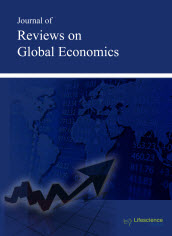jrge
Abstract - Foreign Direct Investment (FDI) and Natural Resources: Blessing or Curse? Empirical Evidence from the Gulf Cooperation Council (GCC)
|
|
Abstract: This paper investigates why foreign direct investment (FDI) inflows are disproportionate among resource and non-resource sectors in oil-rich countries over the period 1980-2017. We constructed a balanced panel of data for Gulf Cooperation Council (GCC) countries from the database of the United Nations Conference on Trade and Development (UNCTAD) and disaggregate data from The Financial Times. We regress total and sectoral FDI inflows on oil rents to a GDP ratio, controlling other socio-economic variables. Our results first consider oil rents. This proxy for natural resources is negatively associated with total FDI inflows. The oil rents/GDP share and resource-based FDI have a significantly positive correlation. However, the adverse effect of oil rents remains true in the case of the non-resource sector foreign investment. Second, oil price fluctuations lead to a rise in the non-resource FDI but discourage resource-related FDI inflows. These empirical results confirm that FDI-Natural resources curse through the crowd-out effect of natural resources in the Gulf Cooperation Council (GCC) countries. Our results are robust to different panel data estimators. Keywords: Foreign Direct Investment, natural resources curse, oil, panel data regression, endogeneity, Gulf Cooperation Council (GCC). |
Abstract - Role of Remittances on Gross Domestic Product (GDP) Growth in Developing Countries: The Case of Bangladesh
|
|
Abstract: Bangladesh is one of the top ten remittance recipient countries and the contribution of remittance to the GDP has increased dramatically in recent years. This study examines the role of remittances on GDP growth in Bangladesh and Time series data for decades from 1996 to 2019 extracted from the World Bank database as well as Bangladesh Bank statistics were used. The study was conducted being motivated from conflicting results that have emerged in the literature on the impact of remittance on the economic growth of different countries. Using ordinary least squares (OLS) and Pearson correlation method, the empirical results of the study have been consistent with some previous studies while also contrasted to some literature on the impact of remittances on GDP, Gross Domestic Savings and Domestic Expenditure of a country. We have found that the remittances have a significant impact on the growth of GDP as well as Gross Domestic Savings and Domestic Expenditure. Since, there are no recent studies on the role of remittances on GDP, therefore, the findings of the study provide a significant insights for policymakers for strengthening policies and regulations relating to harnessing remittances for economic growth. Implications of the study have been discussed. Keywords: Remittances, Economic Growth, Development Level, Bangladesh. |
Abstract - Philippine Household Income Mobility Measurement and its Decomposition using a Pseudo-Longitudinal Panel Data
|
|
Abstract: When economic growth does not translate into poverty reduction and it remains a challenge, it is crucial to examine income mobility since income is a measure of individual economic status or poverty status. To understand the role of economic growth on welfare when there is income mobility, this study measured the Philippine households’ income mobility utilizing pseudo-longitudinal panel data from the Family Income and Expenditures Survey (FIES) of 2003 to 2012. Using various income mobility indices such as chi-square, average jump index and Shorrocks mobility index, the results revealed that the households’ income movement was more mobile than expected. This means that the households’ income status improved through time, low-income rank moved to higher-income rank in a given income distribution. In addition, short-run income inequality was reduced by 87.30 percent (87.30%) when there was income mobility. The presence of income mobility in the country was mainly due to the transfer effect which indicates that households did not take the economic opportunities of economic growth to increase their economic status. Keywords: Economic status, income distribution, income inequality, income mobility, welfare. |
Abstract - Modification of the Modigliani–Miller Theory for the Case of Advance Payments of Tax on Profit
|
|
Abstract: The first serious study (and first quantitative study) of influence of capital structure of the company on its indicators of activities was the work by Nobel Prize Winners Modigliani and Miller. Their theory has a lot of limitations. One of the most important and seriouse assumptions of the Modigliani – Miller theory is that all financial flows as well as all companies are perpetuity. This limitation was lift out by Brusov–Filatova–Orekhova in 2008 (Filatova et al. 2008), who have created BFO theory – modern theory of capital cost and capital structure for companies of arbitrary age. Keywords: Modigliani–Miller theory, advance payments of tax on profit, Brusov–Filatova–Orekhova theory, annuity–immediate, annuity–due. |






















